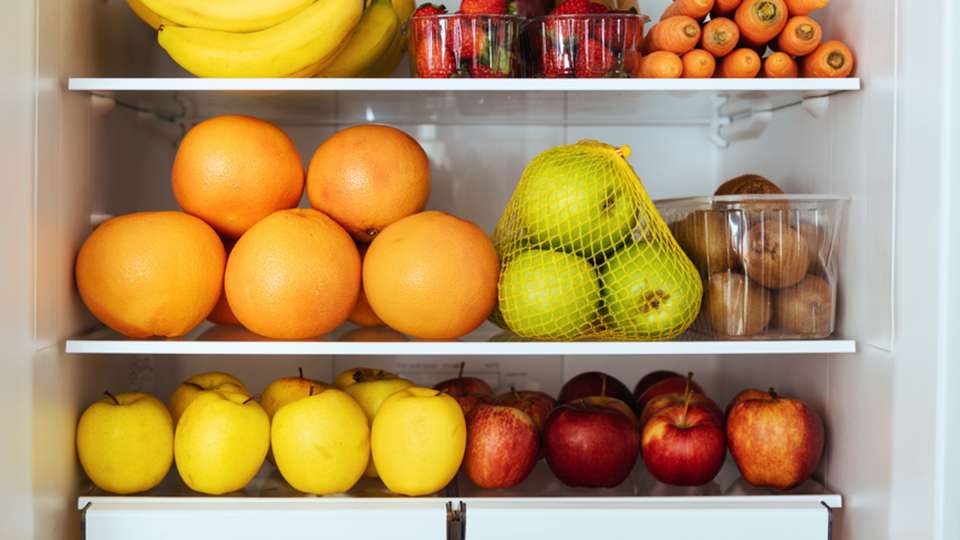
They’re plump. They’re juicy. They’re fresh berries from the farmers market, and you can’t wait to sink your teeth into them.
Until you spot mold. Several spots of mold, actually. Ugh. What’s a fresh fruit connoisseur to do?
Why is fresh fruit so often moldy?
Maybe you’ve noticed that certain types of fresh fruit, like berries, mold more quickly than others, like peaches or apples. (For real though, do apples ever mold?!)
That’s because fruit that has higher sugar and water content is an ideal environment for mold to spread. Fun (?) fact: Most fruit you get likely has some mold spores on it, since spores live in soil and plants and travel easily in air and water.
Is fruit mold dangerous?
“Mold on berries won’t make you sick, as it’s not toxic,” says Judy Simon, a registered dietitian nutritionist at UW Medical Center – Roosevelt.
Rarely, inhaling or ingesting fruit mold can trigger an allergic reaction. But more than likely you could eat a moldy berry or two and not suffer — other than your tastebuds, of course, as mold will make fruit taste just plain wrong.
Apples, grapes and dried fruits can be contaminated by types of mold that tunnel deep into the fruit and produce mycotoxins, which can make you sick and could rarely lead to long-term issues like organ damage or cancer. So if you do see that moldy apple, throw it away.
What’s the best way to keep fresh fruit from molding?
Maybe you saw this coming, maybe you didn’t, but here it is: Refrigerate your fruit.
“Molds prefer warmer temperatures, so when things are refrigerated, they won’t mold as quickly,” says Simon.
Simon refrigerates all fresh fruit she buys except apples and bananas. So yes, even if you’ve been told not to refrigerate things like pears or peaches, you might want to rethink that.
Simon also cleans her refrigerator every couple of weeks so that any stray mold spores aren’t lying in wait to pounce on the next batch of berries she stores.
Thoroughly inspect fruit before you buy it. Look on all sides and the bottom of a bag or container of berries, and when you get it home, open the package and toss any obviously moldy fruits.
Try to be realistic about how much you buy at once so you aren’t getting berries that will sit in the fridge for a week. But if you do have excess, you can freeze it — unwashed is best. Most stores will refund or exchange moldy fruit if you accidentally purchased it that way.
Is it true that you should wait to wash it until you’re ready to eat it?
Yes, this is especially true for berries, Simon says. If you wash them all at once, even if you store them in the fridge, they’ll likely spoil more quickly.
But make sure you do wash them. While accidentally eating a little mold probably won’t harm you, eating unwashed fruit could.
E. coli and other harmful bacteria like to hang out on the surface of fruits, so rinse your produce with water before eating or cooking it. (Yes, even things like avocados that have a skin or rind, as bacteria can transfer from the outside to the inside of the fruit via the knife you use to cut it. And yes, avocados are technically a fruit.)
“Even if it says it’s prewashed, still wash it. That’s how you’ll prevent yourself from getting sick,” Simon explains.
And no, you don’t need to give your fruit a vinegar bath, despite what TikTok might say. It’s true that vinegar has antibacterial properties — it’s great for household cleaning — and is obviously safe to eat, but there’s no evidence it’s any better at cleaning fruit than plain old tap water.
Does one bad berry spoil the bunch?
Generally, no. If you see a few moldy berries in the container, toss them. Inspect the ones in their vicinity to see if they have any signs of mold. If not, they’re fine to eat, as are the rest of the berries.
Is it possible there are spores on the other berries? Yes. Are they likely to harm you? No.
Is it OK to cut off the moldy bits and eat the rest? (Asking for a friend.)
Say you bought some giant peaches but forget to eat them for a few days. You grab one for a snack and notice a small patch of mold. Should you toss the entire peach out? It seems like such a waste …
“If you see small mold spots 1 inch in diameter or less in low-moisture fruits and veggies such as cabbage, bell peppers or carrots, you can cut it away and then eat the non-moldy part,” says Simon. “The USDA does say if you have a big strawberry you could cut off a moldy part, but there’s no way I’m doing it.”
Low-moisture means less water content, so the fruit or veggie will be firmer. If you decide to cut off the moldy part, just make sure you don’t use the knife to cut the rest of it (and possibly spread the mold spores around).
This rule does not apply if you slice into a piece of fruit and see mold on the inside, though. If that happens, into the compost it goes.

 Healthy ideas for your inbox
Healthy ideas for your inbox





